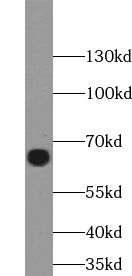Products
SYT1 antibody
| Size | Price |
|---|---|
| 100µg | Inquiry |
- SPECIFICATIONS
- FIGURES
- CONDITIONS
- FAQS
- Product Name
- SYT1 antibody
- Catalogue No.
- FNab08425
- Size
- 100μg
- Form
- liquid
- Purification
- Immunogen affinity purified
- Purity
- ≥95% as determined by SDS-PAGE
- Clonality
- polyclonal
- Isotype
- IgG
- Storage
- PBS with 0.02% sodium azide and 50% glycerol pH 7.3, -20℃ for 12 months(Avoid repeated freeze / thaw cycles.)
- Immunogen
- synaptotagmin I
- Alternative Names
- Synaptotagmin-1|Synaptotagmin I (SytI)|p65|SYT1|SVP65|SYT antibody
- UniProt ID
- P21579
- Observed MW
- 65 kDa
- Tested Applications
- ELISA, WB, IHC, IP
- Recommended dilution
- WB: 1:500-1:1000; IP: 1:500-1:1000; IHC: 1:20-1:200; IF: 1:50-1:500
 human liver tissue were subjected to SDS PAGE followed by western blot with FNab08425(SYT1 antibody) at dilution of 1:1000
human liver tissue were subjected to SDS PAGE followed by western blot with FNab08425(SYT1 antibody) at dilution of 1:1000
 IP Result of anti-Synaptotagmin-1 (IP:FNab08425, 4ug; Detection:FNab08425 1:500) with mouse testis tissue lysate 4000ug.
IP Result of anti-Synaptotagmin-1 (IP:FNab08425, 4ug; Detection:FNab08425 1:500) with mouse testis tissue lysate 4000ug.
 Immunohistochemistry of paraffin-embedded human liver cancer using FNab08425(SYT1 antibody) at dilution of 1:100
Immunohistochemistry of paraffin-embedded human liver cancer using FNab08425(SYT1 antibody) at dilution of 1:100
 Immunofluorescent analysis of ( -20℃ Ethanol) fixed HepG2 cells using FNab08425 (Synaptotagmin-1 antibody) at dilution of 1:50 and Alexa Fluor 488-conjugated Goat Anti-Rabbit IgG(H+L)
Immunofluorescent analysis of ( -20℃ Ethanol) fixed HepG2 cells using FNab08425 (Synaptotagmin-1 antibody) at dilution of 1:50 and Alexa Fluor 488-conjugated Goat Anti-Rabbit IgG(H+L)
- Background
- The synaptotagmins are integral membrane proteins of synaptic vesicles thought to serve as Ca(2+) sensors in the process of vesicular trafficking and exocytosis(PMID: 8058779). SYT1(synaptotagmin I) was firstly identified as a 65-kDa protein with a wide distribution in neuronal and neurosecretory tissue(PMID: 7298720). Calcium binding to SYT1 participates in triggering neurotransmitter release at the synapse(PMID: 11242035). In addition to regulating exocytosis, SYT1 has also been implicated in endocytosis and neurite outgrowth(PMID: 15492212; 11078930; 10336114). This antibody recognizes endogenous SYT1, which has an experimentally determined molecular mass of 65-68 kDa. An additional band of 47 kDa could also be detected, which is corresponding to the calculated molecular weight of SYT1.
How many times can antibodies be recycled?
First, usually it's not suggested to recycle antibodies. After use, buffer system of antibodies has changed. The storage condition of recycled antibodies for different customers also varies. Thus, the performance efficiency of recycled antibodies can’t be guaranteed. Besides, FineTest ever conducted the antibody recycling assay. Assay results show recycling times of different antibodies also varies. Usually, higher antibody titer allows more repeated use. Customers can determine based on experimental requirements.
Notes: After incubation, we recycle rest antibodies to centrifuge tube and store at 4℃. High titer antibodies can be stored for a minimum of one week. Reuse about three times.
What are components of FineTest antibody buffer?
Components of FineTest antibody buffer are usually PBS with proclin300 or sodium azide, BSA, 50% glycerol. Common preservative is proclin300 or sodium azide, which is widely applied in the lab and industry.
How about the storage temperature and duration of FineTest antibodies?
Most antibodies are stored at -20℃. Directly-labeled flow cytometry antibodies should be stored at 2 - 8℃. The shelf life is one year. If after sales issues for purchased antibodies appear, return or replacement is available. Usually, antibodies can be still used after the one-year warranty. We can offer technical support services.
Is dilution required for FineTest antibodies? What’s the dilute solution?
Directly-labeled flow cytometry antibodies are ready-to-use without dilution. Other antibodies are usually concentrated. Follow the dilution ratio suggested in the manual. Dilute solution for different experiments also varies. Common antibody dilution buffers are acceptable(e.g. PBST, TBST, antibody blocking buffer).
How to retrieve antibodies for immunohistochemistry?
Common retrieval buffers: Tris-EDTA Buffer(pH 9.0); Citrate Buffer(pH 6.0)
Heat induced antibody retrieval:
Method 1: Water-bath heating: Put the beaker with retrieval buffer and slide in the boiling water bath. Keep the boiling state for 15min. Naturally cool to room temperature;
Method 2: Microwave retrieval: Put the beaker with retrieval buffer and slide in the microwave oven. Heat at high power for 5min, Switch OFF for 3min, Heat at medium power for 5min. Naturally cool to room temperature.
How to choose secondary antibodies?
(1) Secondary antibodies react with primary antibodies. Thus, secondary antibodies should be against host species of primary antibodies. E.g. If the primary antibody is derived from rabbit, the relevant secondary antibody should be against rabbit. E.g. goat anti rabbit or donkey anti rabbit.
(2) Choose secondary antibody conjugates according to the experimental type, e.g. ELISA, WB, IHC etc. Common enzyme conjugated secondary antibodies are labelled by HRP, AP etc. Fluorescin or dye labelled secondary antibodies are applied in immunofluorescence and flow cytometry(e.g. FITC, Cy3).
